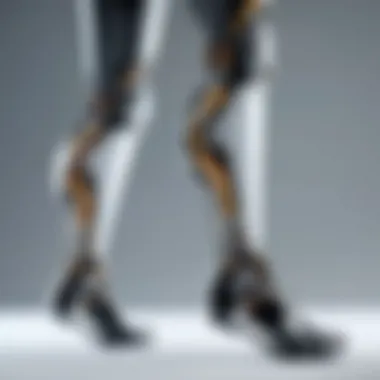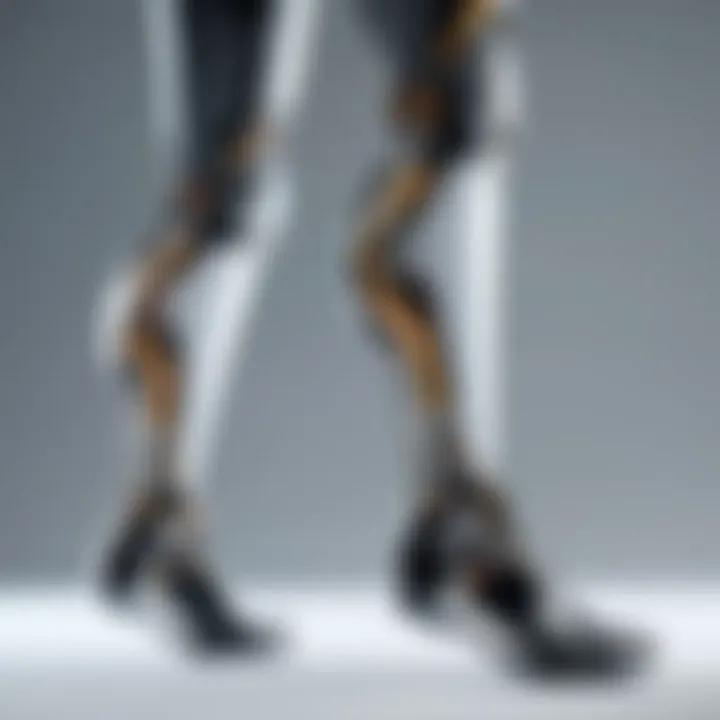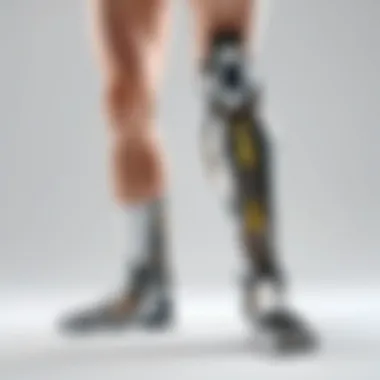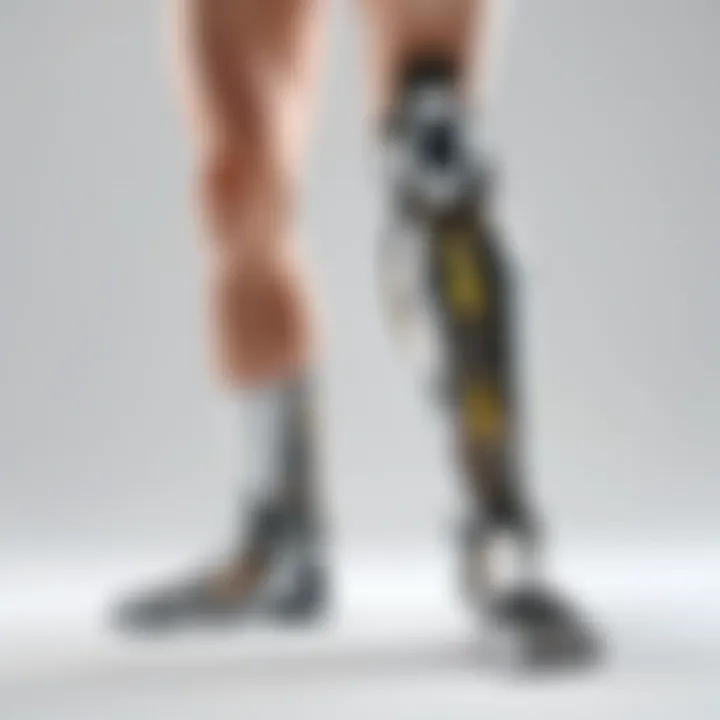Cyborg Legs: Technology and Future Implications


Intro
In recent years, the fusion of technology and human anatomy has entered a new phase, one that feels almost like a plot twist in a science fiction novel. Cyborg legs, a marvel of biomechatronics, symbolize the intersection between robotics and rehabilitation. With these advancements, we don’t just observe; we participate in a reality where mobility is enhanced through machines integrated seamlessly with our biological systems.
The journey to this point has not been a simple walk in the park. From the first rudimentary prosthetics to the sophisticated devices available today, the evolution of cyborg legs covers a broad canvas of innovations, ethics, and human experiences. This article aims to delve into the intricate layers surrounding these technological breakthroughs, offering a detailed exploration of their implications on society and future mobility.
We'll explore how these devices work, the enhancements they've brought to their users, and the broader debates about what it means to augment the human body. By doing so, we hope to shine a light on the path ahead—where rehabilitation may transform lives and innovation takes on a new meaning.
Let’s roll up our sleeves and uncover the various facets of cyborg legs, starting with a look at the technology insights in this fascinating arena.
Preamble to Cyborg Legs
Cyborg legs represent a fascinating frontier in both technology and rehabilitation. As the line between human capabilities and mechanical enhancements blurs, understanding the significance and implications of cyborg technology becomes crucial. This introduction sets the stage for a comprehensive exploration of how cyborg legs not only aid mobility but also redefine human potential.
The advent of cyborg legs is not merely about replacing lost limbs; it embodies a paradigm shift where technology empowers individuals, enabling them to engage with their environment in previously unimaginable ways. From a functional perspective, cyborg legs enhance the quality of life for amputees and those with mobility impairments, serving as a bridge between traditional prosthetics and advanced robotic systems.
Moreover, these advancements bring along a slew of considerations—technical, ethical, and social. There’s a pressing need to discuss the ramifications of relying too heavily on technology for mobility, especially regarding autonomy and identity. What does it mean to enhance human abilities artificially? Are we ready to navigate the complex landscape of such profound changes?
Defining Cyborg Technology
Cyborg technology involves the integration of artificial components with human biological systems. This can range from simple devices enhancing sensory input to complex robotic limbs that can perform tasks independently. At its core, a cyborg represents the merging of machine and human functions, pushing the boundaries of traditional prosthetics.
Cyborg legs specifically leverage advancements in biomechanics, robotics, and neuroscience. They include sophisticated mechanisms such as sensors and actuators that replicate natural movement, allowing for smoother transitions in walking and running. These legs are often equipped with microprocessors that adjust to different terrains and user movements in real-time, offering a seamless experience akin to natural ambulation.
Historical Context and Development
The journey toward modern cyborg legs is laden with various innovations and milestones. Initially, prosthetic limbs were rudimentary, offering limited functionality. However, the late 20th century saw a significant leap forward due to advancements in materials and engineering. The introduction of lightweight, durable materials allowed for better-fitting prosthetics that significantly improved user comfort.
As the new millennium rolled in, the focus shifted towards integrating electronics into prosthetics, leading to the birth of powered legs. Early iterations utilized basic motors to assist with movements but lacked the intelligence present in today’s models. This evolution is not just about hardware; it’s equally about software innovations that facilitate natural movement dynamics.
"The blend of human physiology with cutting-edge technology prompts us to rethink our understanding of what it means to be human."
In recent years, the rise of artificial intelligence has turbocharged this domain. Machine learning algorithms can now analyze a user’s walking patterns, adapt to changes, and predict movements, making cyborg legs more responsive than ever. Today’s models are marvels of engineering, showcasing profound improvements in mobility that promote independence and confidence among users.
In summary, cyborg legs are more than just technological marvels; they serve as a lens through which we can view the intersection of human experience and advanced engineering. As we delve deeper into this topic, it’s essential to keep an eye on both the motivations driving these advancements and the challenges they pose to our traditional notions of mobility and identity.
Biomechatronics and Its Role in Cyborg Limbs
Biomechatronics is the intersection where biology meets engineering, particularly in the realm of human enhancement. This branch of science plays a pivotal role in the design and functionality of cyborg limbs, specifically cyborg legs, which serve as a lifeline for individuals seeking mobility solutions beyond traditional prosthetics. It’s a blend of multiple disciplines including robotics, biomechanics, and of course, electronics, ensuring that these advanced limbs not only replace lost functionality but ideally enhance it.
Cyborg legs are essentially the physical representation of biomechatronics in action. They are designs that directly mimic the natural movement of human limbs, taking into account the wearer's biological characteristics. The importance of biomechatronics in cyborg technologies cannot be overstated. It underscores how we can utilize technological innovations to profoundly change lives — enabling greater independence versus reliance.
Even as we push the limits of what is possible, biomechatronics raises some thoughts. For anyone interested or involved in the design of cyborg limbs, understanding the integration of biological functions with mechanical ones is crucial. This understanding leads towards creating more intuitive and user-friendly devices.
With biomechatronics, the benefits of cyborg legs stretch beyond improved mobility. They offer potential for:
- Enhanced balance and stability, which is crucial for individuals recovering from severe injuries.
- Increased adaptability to various terrains, thanks to advanced sensors and actuators.
- Better control accommodating a wide range of user preferences and requirements.
Considering these significant points, it's clear that biomechatronics is not merely a technical term; it embodies a lifestyle shift for many.
Understanding Biomechatronics
To unpack biomechatronics further, we should think about its foundational elements — the integration of biological aspects with mechanical engineering. Imagine a world where artificial limbs could respond to a user’s brain signals or physical reactions almost instantaneously. This is not just wishful thinking; it's happening. Understanding how biomechatronics works means recognizing its components. Things like sensors that track physical activity and actuators that mimic muscle contractions.
The core idea here revolves around the idea of adaptability. Each limb must work seamlessly with the body, adapting to the user’s needs in real-time. This includes sensing pressure, momentum, and even the slightest nuanced movements, which often go unnoticed in traditional prosthetics. Biomechatronics thus represents not just an improvement in functionality, but a massive leap towards human enhancement.
Integration of Sensors and Actuators
The integration of sensors and actuators into cyborg legs is where the magic happens. Think of how your smartphone responds when you tap the screen; it’s instantaneous, right? Now apply that concept to a leg that can respond to your movements almost as if it were an extension of your own body. Sensors play a crucial role in gathering data, while actuators execute the required actions based on that data.


Key components often include:
- Force Sensors: To detect weight distribution and adjust the leg's support accordingly.
- Gyroscopes: For maintaining balance, particularly useful for navigating uneven surfaces.
- Electromyography (EMG) Sensors: These can read muscle signals directly from the user, allowing movements to be executed with an intention-driven interface.
This intricately designed feedback loop allows for smoother and more natural movement, reducing the learning curve that typically accompanies using a prosthetic limb. With real-time data processing, users can enjoy a fluid interaction with their environment. All of these elements are part of what makes cyborg legs not just tools, but partners in mobility. This evolution aims to create a seamless experience, making the user's transition to using such technology as simple as pie.
Types of Cyborg Legs
Understanding Types of Cyborg Legs is crucial because these advancements significantly enhance mobility options for individuals affected by various conditions. This section dives into two key categories of cyborg legs: prosthetic cyborg legs and exoskeleton technologies. Each type plays a distinct role in addressing specific needs, reflecting the growing complexity and capability of biomechatronic devices.
Prosthetic Cyborg Legs
Prosthetic cyborg legs have seen promising advancements over the years, improving the quality of life for amputees. These devices are designed to replace lost limbs and restore functionalities which often seem lost forever.
The intricate design of prosthetic legs integrates cutting-edge materials and technologies. For instance, you have the microprocessor-controlled prosthetics that monitor the user’s movements in real-time. These legs can adjust accordingly, resembling a natural gait much more closely than traditional prosthetics. The importance here lies not only in regaining the ability to walk but in doing so with a level of comfort and efficiency that has not been possible until recently.
"Prosthetic limbs are no longer merely wooden peg legs but dynamic devices that respond to the wearer’s needs and movements."
From a technical standpoint, developments like bionic feedback systems provide sensory feedback through electrodes in the skin. It allows users to feel sensations, creating a close resemblance to a biological limb. With ongoing research and innovation, prosthetic legs continue to evolve, becoming more user-friendly and attuned to the individual's daily realities.
Moreover, one of the significant benefits of prosthetic cyborg legs is the psychological empowerment they provide. Many users report a higher quality of life and increased independence. This aspect emphasizes the multifaceted impact these devices have beyond just mobility, positively affecting mental health and social integration.
Exoskeleton Technologies
On the flip side, exoskeleton technologies serve a different purpose: they are not replacements but enhancements. This category is designed to assist those with limited mobility due to injury or other physical challenges. By external structures that support and amplify human movement, exoskeletons facilitate mobility where it was previously hindered or lost.
These machines strap onto the user’s body and provide mechanical assistance for walking, standing, and even lifting heavy objects. One of the standout examples includes the ReWalk, a battery-operated exoskeleton that enables individuals with spinal cord injuries to walk again. The device uses sensors to detect shifts in the user’s center of gravity and adjusts its movements accordingly.
The implications of exoskeletons are vast. They not only improve the physical capabilities of individuals but also extend to rehabilitation. During therapy sessions, exoskeletons can help patients relearn to walk by providing vital support that would be impossible without such devices.
In summary, examining the types of cyborg legs reveals how both prosthetic and exoskeleton technologies are redefining mobility. They each cater to different needs while embodying the remarkable synergy of technology and human capability. It’s a transformative journey that invites us to reconsider not just the limitations of physical disabilities but the incredible potential of human enhancement.
Technological Innovations in Cyborg Legs
In the ever-evolving landscape of prosthetic design, the integration of advanced technologies is a game changer. Technological innovations in cyborg legs embody significant advancements that not only enhance mobility but also improve the day-to-day lives of their users. A focus on microprocessors, AI capabilities, and efficient power management showcases the intricate dance between human physiology and machine intelligence.
Microprocessor-Controlled Limbs
Microprocessor-controlled limbs represent a pivotal leap forward in cyborg technology. Unlike traditional prosthetics that operate on basic mechanics, these smart limbs are equipped with microprocessors that enable dynamic responses to various walking conditions. They can analyze and adjust movements in real-time, offering a more natural gait.
For instance, consider a person navigating varied terrain, such as shifting from a smooth surface to a rocky path. The microprocessors allow the leg to adjust stiffness and movement patterns, effectively providing feedback that helps the user maintain balance and stability. The benefits of such technology are vast:
- Enhanced Stability: Reduces the risk of falls.
- Personalization: Adaptations can be tailored to individual walking styles.
- User Comfort: Many users report less fatigue, as the limbs work to ease the demands on their muscles.
Still, it’s essential to note the complexity of these systems. With intricate software embedded in them, the potential for bugs exists, which might impact performance. Designers and engineers are tackling these challenges head-on to ensure reliable operation in all scenarios.
Advanced Robotics and AI Integration
The rise of robotics and AI integration into cyborg legs goes beyond mere mechanics – it opens doors to a realm where machines learn and adapt. These limbs incorporate algorithms that evolve over time, leading to improved efficiency based on user habits and environmental interaction.
AI algorithms can facilitate a connection between the user and the limb, ensuring that it becomes an extension of the body, rather than just an aid. Imagine an exoskeleton leg that recognizes when its user is ascending stairs versus walking on level ground; it can adjust actively, making life smoother.
- Enhanced Mobility: Users find it easier to navigate their surroundings.
- Learning Capability: As the system learns, it becomes more intuitive, anticipating user needs.
- Greater Control: Allows for more precise movements, which can enhance overall user experience in activities ranging from walking to sports.
However, embedding AI raises ethical questions. Privacy concerns regarding data collection and the potential for misuse are subjects of ongoing discussions among technologists and ethicists alike.
Battery Technology and Power Management
Power is the backbone of any technological solution, and advancements in battery technology play an integral role in the functionality of cyborg legs. Current trends emphasize not only longevity but also the safety and efficiency of power management systems.


The newest batteries are being designed to be lighter and more compact, offering sustained use while maintaining a manageable weight for the user. Some modern designs even feature fast-charging capabilities, ensuring that users can quickly recharge their legs without lengthy downtimes.
Key points regarding battery technology include:
- Lithium-ion Innovations: These batteries have become the go-to for many devices due to their capacity-to-weight ratio.
- Smart Power Management: Systems that monitor and report on energy usage can extend battery life and enhance performance by optimizing how and when power is drawn.
- Long-Duration Applications: With many users engaging in day-to-day activities for hours on end, it's critical for the batteries to support sustained performance.
As cyborg technology progresses, the balancing act between power efficiency, weight, and usability will become more crucial. This is an area that warrants continuous innovation as developers aim to meet the sprawling demands presented by active lifestyles.
"The ability of cyborg legs to mold themselves to user needs signifies not just technological growth; it symbolizes a societal shift towards embracing enhanced human capabilities."
User Experience with Cyborg Legs
The realm of cyborg legs is not only about marveling at technological feats—it's fundamentally about how these advancements affect the everyday lives of users. The user experience is where imagination meets reality, shaping the shift from mere functionality to genuine human connection. This aspect is vital as it addresses how individuals adapt to and ultimately benefit from these innovations. The ways in which cyborg legs can enhance mobility and independence for those who rely on them reflect the potential for profound societal change.
Adapting to New Technology
Adjusting to cyborg legs requires more than just familiarity with a new gadget; it often entails a significant mental and emotional recalibration. For many users, the shifts can feel monumental. Individuals accustomed to traditional prosthetics or mobility aids find themselves navigating a learning curve that merges human movement with advanced technology.
For instance, using sensors that respond to muscle signals is no small feat. At first, the instinctive actions that accompany walking, like shifting weight and balancing, must be retrained with these high-tech limbs. Upholding one’s confidence in public spaces can trickle down from mastering these skills in private. The adaptation process involves:
- Building muscle memory with a robotic component.
- Learning how to trust artificial movement in various terrains.
- Overcoming mental barriers related to identity and capability.
In addition, users experience changes in perception from both themselves and their surroundings. When they step out with cyborg legs, they are likely met with a range of reactions from others—fascination, curiosity, and sometimes, misunderstanding. Each interaction can influence their comfort, impacting how they navigate society as technological pioneers.
Feedback from Users
Gathering user experiences provides invaluable insight into the strengths and areas for improvement in cyborg leg technology. Feedback typically highlights a mix of gratitude for independence restored and frustrations regarding aspects like comfort or responsiveness. Users often report feeling:
- Empowered—many express that cyborg legs have granted them a sense of control over their mobility, which was often lacking before.
- Frustrated—some devices may not align perfectly with their natural movement patterns, leading to complications like discomfort or fatigue during extended use.
- Optimistic—despite challenges, there is a palpable hope for refinement through technology as more feedback reaches developers.
One compelling story comes from a user who shared their transition experience on a forums like reddit.com, stating, "The first time I walked several blocks without resting, I felt unstoppable. But later, I realized the device pinched my skin. It's a journey of ups and downs." Such narratives underscore the emotional landscape surrounding cyborg legs and highlight users' resilience and desire for improvement.
"Technology influences how we see ourselves, but it's the human experience that defines how we live with it."
This phrase encapsulates that user experience goes beyond mere mechanics; it delves into integrating cyborg legs into one’s life, encompassing joy, trials, and the spirit of pushing boundaries. Making sense of these experiences is critical for developers and healthcare professionals to ensure that cyborg legs not only serve their purpose but enhance the full fabric of human experience.
Rehabilitation and Training Programs
Rehabilitation and training programs are cornerstones in the journey of individuals adapting to cyborg legs. These programs not only facilitate physical recovery but also ensure that users gain the skills needed to integrate these advanced technologies into their daily lives. The significance of these programs cannot be overstated; they form a bridge between the raw potential of cyborg technology and the practical realities of mobility and functionality.
Physical Therapy Approaches
Physical therapy plays a pivotal role in how users adapt to cyborg legs. Unlike traditional prosthetics, which often require a more straightforward adjustment period, cyborg legs involve a complex interaction between human movement and advanced mechanics. Therapists employ various approaches tailored to individual needs.
- Sensory Integration Therapies: These strategies focus on enabling the user’s remaining sensory inputs to interact effectively with the mechanical components of the cyborg legs.
- Strength and Conditioning Programs: Users often face unique challenges. Programs designed to strengthen the muscles that support the cyborg technology can lead to better outcomes.
- Mobility Scaling: Patients can start with basic movements and gradually escalate to more complex actions, ensuring that the integration happens naturally and effectively.
Improving balance, coordination, and agility not only enhances independence but also uplifts the user’s confidence. It can be a slow process, sometimes requiring months or even years to reach optimal function. As everyone adapts differently, therapists constantly adjust their methods.
"The goal is not just to walk again, but to walk better and with a sense of freedom."
Role of Assistive Technology
Assistive technology is a vital part of rehabilitation for cyborg leg users. These innovations help bridge gaps and provide extra support in the transition phase. Some key elements include:
- Feedback Systems: Many cyborg legs include feedback mechanisms that inform users about their stance and balance. This data can be used to refine movements during rehabilitation.
- Mobile Applications: Users can track their progress through smartphone apps that analyze performance statistics. This can lead to a more personalized approach to training.
- Virtual Reality Simulations: These setups create safe environments for users to practice walking or navigating obstacles, helping them mentally prepare for real-world interactions with their cyborg legs.
The intersection of bodily rehabilitation and tech innovation ensures a smoother transition. With these tools at hand, users can build the confidence needed to embrace their new capabilities while minimizing frustrations that arise during the adaptation process.
Ethical Implications of Cyborg Legs


The rise of cyborg legs brings a host of ethical implications that cannot be overlooked. As technology advances and becomes integrated into our bodies, it raises questions about personal identity, autonomy, and societal norms. These issues become even more pressing when considering that cyborg legs are not just tools for mobility; they symbolize a shift in our understanding of what it means to be human. Engaging with these ethical concerns is crucial for guiding future developments in this field.
Body Integrity and Autonomy Considerations
One of the foremost ethical dilemmas related to cyborg legs involves body integrity and autonomy. Body integrity refers to the importance of keeping the human body whole and unaltered. When individuals use cyborg legs, they are essentially altering their natural anatomy. This brings into question how much technology should intrude into our physical being.
- Personal Choice: Some view cyborg legs as a personal choice—a way to enhance or restore mobility. Here, autonomy plays a vital role. For many, the decision to use these advanced devices is deeply personal and signifies empowerment rather than impairment.
- Consent Issues: However, this raises another layer of concern. Are individuals truly able to make informed choices about using cyborg legs? Factors such as social pressure and medical necessity can complicate what seems like a straightforward decision.
Moreover, a societal lens often influences how people perceive these technologies. For instance, if cyborg legs become seen as the 'gold standard' for mobility, those who choose not to use them may face stigma or isolation. This dynamic can inadvertently pressure individuals into adopting enhancements they may not desire, leading to a loss of personal autonomy.
Societal Acceptance of Enhanced Abilities
As cyborg legs become more commonplace, their societal acceptance raises fundamental questions about enhancement versus disability. In cultures that prioritize normalcy, any deviation from the norm can be met with skepticism.
- Cultural Implications: In developed societies, there seems to be a dichotomy between acceptance of assistive technologies and a distrust of enhancement. For example, while prosthetic limbs are generally accepted for individuals with disabilities, the use of cyborg technology for able-bodied individuals to "enhance" capabilities can face backlash.
- Fear of Inequality: Another concern is that cyborg legs could widen the gap between the haves and the have-nots. People with access to cutting-edge technology may experience improved mobility, enhancing their opportunities, while others are left behind due to socioeconomic disparities. This fear of inequality poses critical questions about what type of future society wants to build.
"The advent of cyborg technology presents a unique blend of possibilities and dilemmas, challenging our definitions of ability, autonomy, and what it means to be human."
Ultimately, ethical considerations surrounding cyborg legs are multifaceted and complex. They encompass personal autonomy, societal acceptance, and broader implications for individuals and communities. As the technology continues to evolve, it’s vital that these discussions remain at the forefront to ensure that cyborg legs—in all their potential—are developed and integrated in a manner that respects human dignity and values.
The Future of Cyborg Legs
The topic of The Future of Cyborg Legs holds significant importance in understanding the trajectory of mobility technology and its implications for society. As we delve into this realm, it becomes evident that innovation in cyborg legs is not merely about enhancement but is also deeply intertwined with medical advancements, ethical considerations, and societal perspectives.
Emerging Technologies
A variety of exciting technologies is emerging that could redefine the capabilities of cyborg legs. The continuous refinement of 3D printing offers opportunities to create custom prosthetic limbs at a fraction of the time and cost, which means that personalized solutions can become accessible to a broader audience. Another promising avenue is the incorporation of biomaterials, which mimic human tissue more closely than traditional materials, allowing for greater comfort and functionality.
Furthermore, machine learning algorithms play a crucial role in developing responsive systems. These algorithms can analyze the wearer’s movements and adapt accordingly, improving the user experience significantly. For instance, a cyborg leg might learn to adjust for different terrains, enhancing mobility in various environments like rocky trails or sandy beaches.
Another dimension is the advancement in battery technology. To alleviate concerns about mobility limitations due to power, new developments in energy-dense batteries – for instance, solid-state batteries – can keep users active longer than previous technologies. This ensures that users are not restricted by the duration of battery life, leading to more freedom in their daily activities.
"In the realm of technology, every stride taken has a ripple effect, shaping what tomorrow will look like."
Potential for Broader Applications
The implications of cyborg legs extend beyond just mobility for individuals. As technologies advance, the potential applications might encompass broader horizons. For instance, military use of enhanced limbs is already being explored, allowing servicemen and women to regain full physical capabilities post-injury or to improve performance in the field. Additionally, imagine a world where all kinds of workplace enhancements become commonplace, providing workers in physically demanding jobs with assistive technology to safely and efficiently complete their tasks.
Beyond individual and occupational applications, there is also room for healthcare integration. The use of cyborg legs in rehabilitation settings represents a significant leap. Physical therapy can be revolutionized, as customizable cyborg legs enable tailored recovery programs that adapt in real time to the user's progress and needs. This could mean accelerated recovery times and improved outcomes for those undergoing rehabilitation for injuries.
Moreover, envision the potential for sports. Athletes, both with and without disabilities, may benefit from the unique capabilities of advanced cyborg legs, leading to a new era in competitive sports where abilities expand rather than contract. As we continue to innovate, the lines between ability and enhancement blur, fostering a culture that embraces difference and advancement.
In summary, the future of cyborg legs is not just about enhancing individual capabilities but also about creating a society where technology and humanity intersect seamlessly, promoting greater inclusivity and functionality. As we stand on the brink of these advancements, it is crucial to consider both the potential benefits and the ethical implications that accompany such rapid technological evolution.
End: The Impact of Cyborg Legs
The discussion surrounding cyborg legs is not simply a dive into advanced technology; it's about rethinking the very essence of mobility and capabilities in the human experience. As we've explored throughout this article, cyborg legs represent a significant leap in biomechatronics and enhance the quality of life for numerous individuals. These innovative limbs not only restore movement but also redefine the potential of what it means to be human, blending biology with cutting-edge technology.
Summary of Key Points
In summarizing our exploration, we can identify several key points that highlight the importance of cyborg legs:
- Technological Integration: The integration of sensors and actuators has improved the responsiveness and adaptability of prosthetic devices, making them more intuitive for users.
- User Experience: Real accounts from users reveal that cyborg legs provide them not only with mobility but also a renewed sense of independence and control over their lives.
- Rehabilitation Advances: Enhanced training programs utilizing assistive technologies are paving the way for better adaptation and support in recovery processes, showcasing the potential long-term benefits.
- Ethical Dimensions: Discussions around body integrity and the societal acceptance of these technologies indicate the need for a cultural shift in how we perceive enhancement and disability.
- Future Outlook: As technology continues to improve, the applications for cyborg legs are reaching beyond rehabilitation, hinting at possibilities in industries like sports, military, and even entertainment.
The interplay of these factors illustrates not just an advancement in technology but a profound transformation in societal narratives regarding mobility and capabilities.
Final Thoughts on Mobility and Human Enhancement
The implications of cyborg legs extend beyond mere physical restoration; they invite a broader conversation about our future. As we embrace these advancements, we must also engage with the underlying ethical considerations that come with them.
These innovations showcase technology's role in enhancing human lives, raising important questions about identity, autonomy, and societal norms. Will the adoption of these technologies lead to a normalization of enhanced mobility? Or will discrepancies in access create new forms of inequality?
As the line between human capability and technological enhancement blurs, it’s crucial for society to actively participate in these discussions. Understanding the perspectives of users, continuous feedback, and collaboration among engineers, ethicists, and users themselves will ultimately shape the future of cyborg legs and similar technologies.
" as we advance, we tread a fine line between enhancement and ethical responsibility, steering the course of humanity alongside technology."
The journey towards embracing cyborg legs is only beginning, and its impact will resonate across various facets of life. Engaging thoughtfully with these developments is essential for ensuring that as we step forward into this new future, we do so with care, foresight, and inclusivity.







